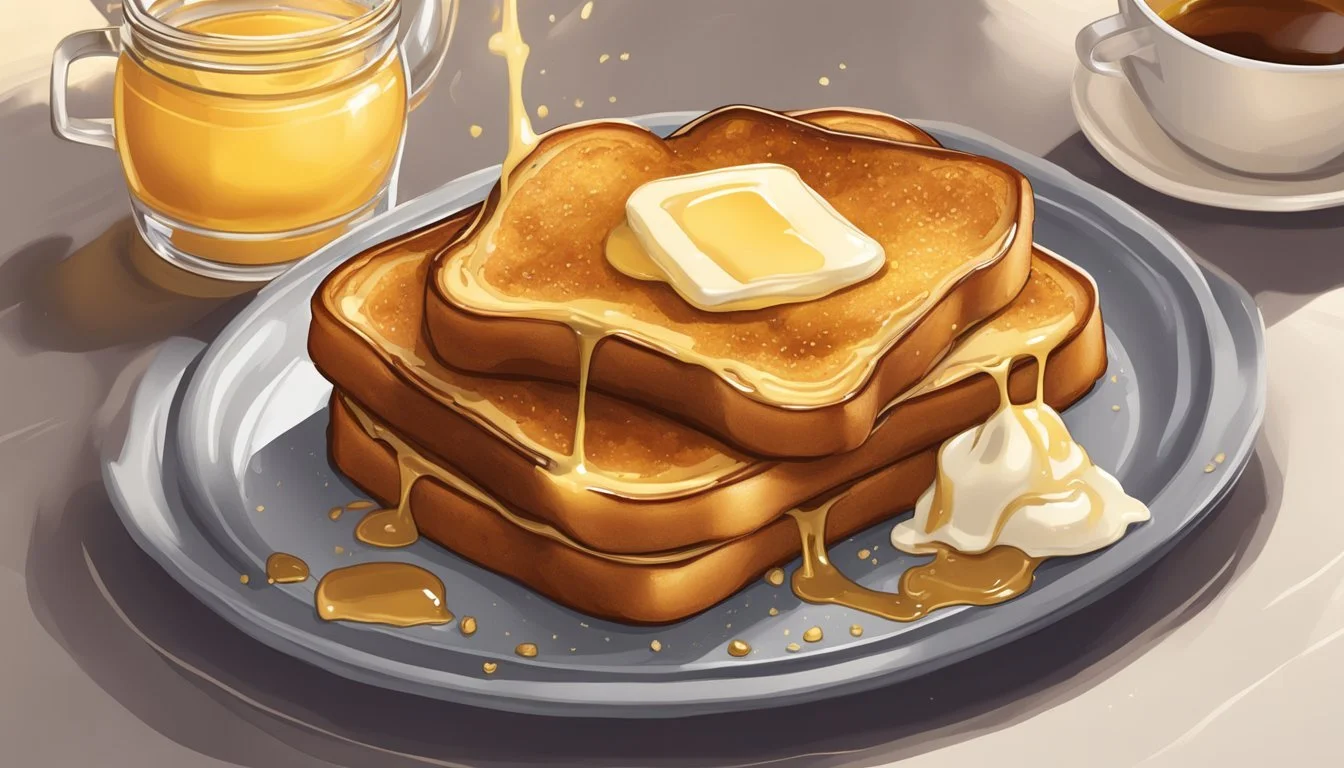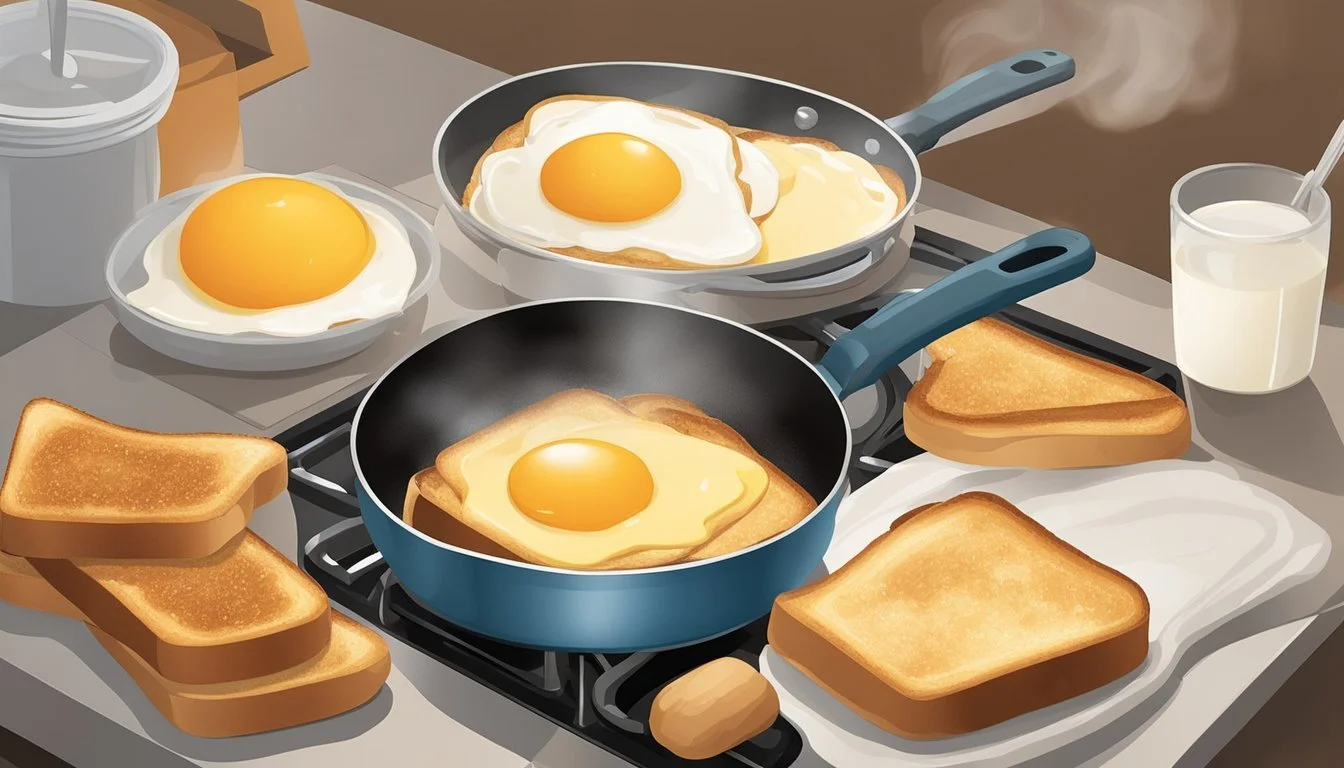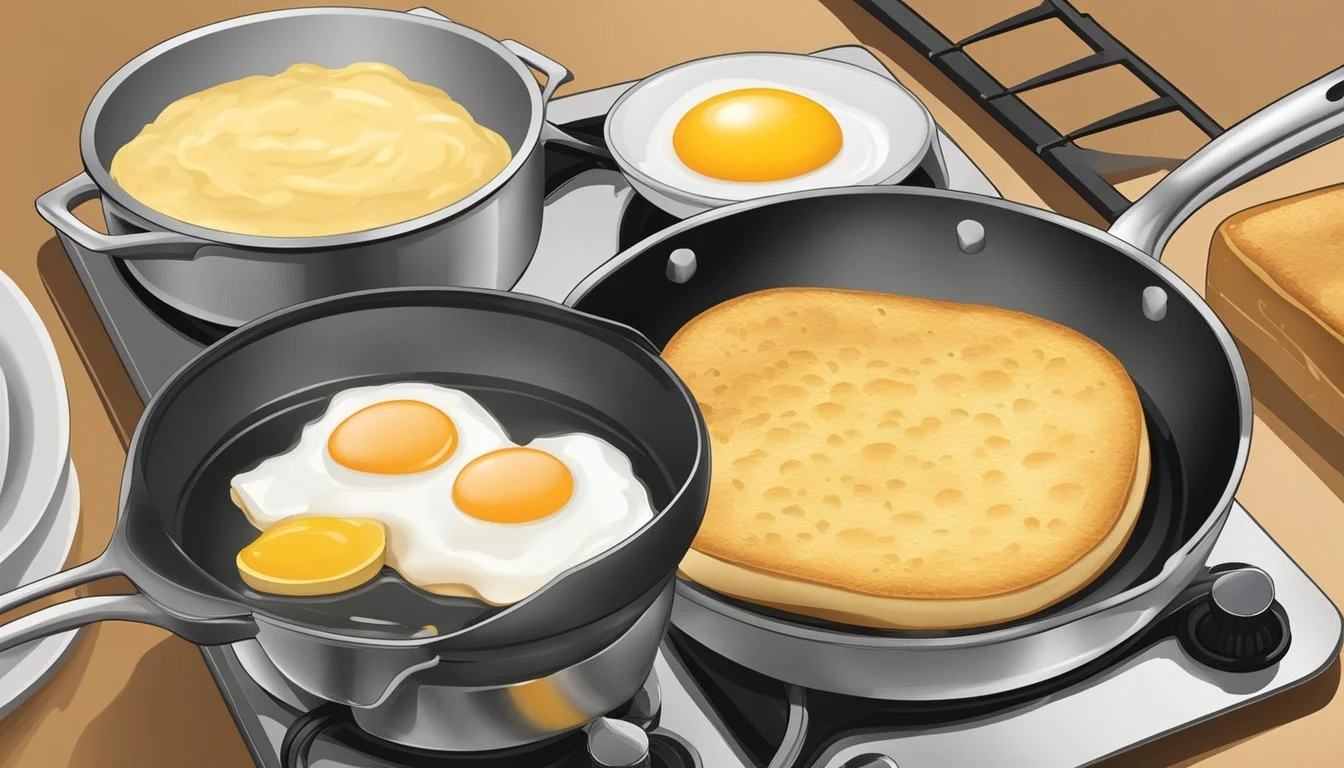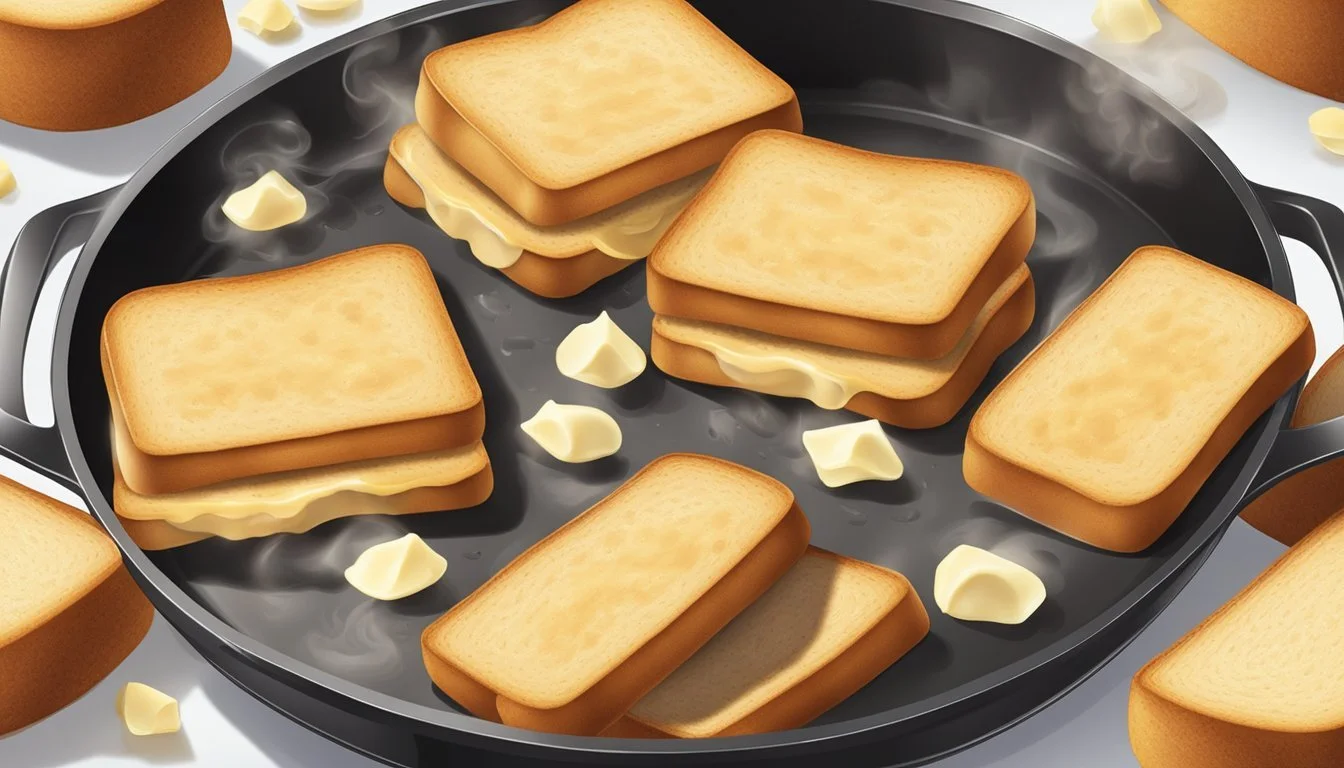The Stovetop French Toast
Mastering the Art of Classic Breakfast Without a Toaster
Stovetop French toast stands as a testament to the versatility of classic breakfast comfort food. Traditionally, this dish involves soaking slices of bread in an egg-based batter, typically enriched with milk or cream and flavored with elements like vanilla or cinnamon. In a modern kitchen, one might reach for an electric toaster to crisp up their bread, but French toast harkens back to simpler cooking methods. It is prepared on the stovetop, using nothing more than a skillet, making it perfectly accessible to those without specialized kitchen appliances.
The process for crafting French toast on the stovetop is straightforward and allows for a customizable breakfast experience. Bread, once dipped in the batter, is cooked in a pre-heated pan until it achieves a golden-brown exterior that yields a slightly crisp texture, contrasting well with the tender, custard-like interior. Keeping the heat at a medium to medium-high level ensures that each piece cooks evenly without burning, typically taking around four minutes per side to reach perfection.
It's the stovetop method that makes French toast not only a flavorful start to the day but also a convenient option for many. This cooking technique doesn't require complex gadgets, yet it delivers a dish that's satisfying and adaptable to various toppings and mix-ins. Whether served simply with powdered sugar and syrup, or adorned with fresh fruit or a dusting of spices, French toast prepared on the stovetop remains an enduring favorite at the breakfast table.
The Basic Ingredients of French Toast
The creation of French Toast begins with a few fundamental components, each playing a pivotal role in the dish's texture and taste. From the choice of bread to the custard mixture and final flavor enhancements, each element contributes to the character of the final dish.
Selecting the Right Bread
For optimal results, chefs typically recommend dense and slightly stale bread such as challah or brioche. Their thick slices and rich texture are ideal for soaking up the egg mixture without falling apart. Bread that is a day or two old tends to work better as it absorbs more liquid and retains its structure during cooking.
Challah: A traditional Jewish bread that is eggy and slightly sweet.
Brioche: A French bread known for its high butter and egg content, giving it a tender crumb and rich flavor.
Eggs, Milk, and Cream
The custard base for French Toast traditionally includes eggs and whole milk or heavy cream, each contributing to the richness and creaminess of the dish.
Eggs: Provide structure and help bind the mixture to the bread.
Whole Milk: Offers a perfect balance of fat and flavor.
Heavy Cream: For a richer custard, some prefer to use heavy cream, alone or mixed with milk.
Sweeteners and Flavorings
The final touch to the custard base comes from sweeteners and flavor additives that create a signature taste profile. Granulated sugar provides a sweet backdrop, while cinnamon and pure vanilla extract impart warm and aromatic notes to the toast.
Granulated Sugar: Adds a touch of sweetness without overpowering the dish.
Cinnamon: Lends a gentle spice that complements the vanilla perfectly.
Pure Vanilla Extract: Imparts a classic, aromatic flavor that elevates the toast beyond its humble beginnings.
By carefully choosing and balancing these ingredients, one can craft a delightful French Toast that is sure to please any breakfast table.
Preparation Techniques
Mastering French toast preparation on a stovetop involves simple yet specific techniques that ensure a delicious outcome. The process includes whisking a custard base, soaking the bread effectively, and cooking to a perfect golden brown finish.
Whisking the Eggs
One begins by creating the base of the French toast, which is essentially a custard. In a shallow bowl, whisk together large eggs, typically two to three depending on the serving size. To this, they add milk or cream, integrating elements like cinnamon or vanilla for flavor. The goal is to have a smooth and well-incorporated mixture without any streaks of egg white or yolk.
Ingredients: Large eggs, milk/cream, cinnamon/vanilla (optional)
Action: Thorough whisking until smooth
Dipping and Soaking
Once the custard is ready, the cook proceeds to dip each slice of bread into the mixture. The technique here is to allow the excess to drip off to avoid sogginess while ensuring the bread is adequately soaked to absorb the flavors. A balanced soak time is crucial – too short, and the interior remains dry; too long, and the slice may fall apart.
Process: Dip each side, let excess drip off
Tip: Use a fork to handle the bread, preventing breaks
Cooking on the Stovetop
The cooking step calls for a cast iron skillet or non-stick skillet set over medium-high heat. One can use butter or oil to grease the pan for that crisp exterior while preventing sticking. The bread is cooked until it reaches a golden brown color on each side, a sign of perfect readiness. It should take approximately 2-3 minutes per side, depending on the heat and size of the slices.
Tools: Cast iron skillet or non-stick skillet
Medium: Butter or oil
Indicator: Golden brown color
The ensuing French toast is ready to serve hot, oftentimes with a dusting of powdered sugar, a drizzle of syrup, or a sprinkle of fresh berries to complement the rich, custardy interior.
Cooking Without a Toaster
For those without a toaster, creating the perfect French toast on the stovetop is not only possible but can also yield delicious results. By mastering a few techniques and understanding alternative cooking methods, one can achieve toast with the desired texture and flavor using basic kitchen equipment.
Utilizing the Skillet
To cook French toast without a toaster, a skillet is an ideal tool. One should select a sturdy pan that distributes heat evenly, such as a cast-iron skillet. To begin, heat the skillet over medium-high heat and add a small amount of butter to coat the surface. The bread should be cooked for a few minutes on each side until a golden-brown crust forms. Regular flipping is key to preventing burnt toast.
Procedure in Skillet:
Heat skillet over medium-high heat.
Add butter to coat.
Place bread in skillet and flip every 2-3 minutes.
Toast each side until golden brown.
Achieving the Perfect Texture
The texture of French toast is paramount. For a crisp exterior with a soft, custard-like center, bread should be soaked in the customary mixture of eggs, milk, and sugar, but not oversaturated. Soak each side for a few seconds and allow excess liquid to drip off before transferring to the hot skillet. Managing the heat is crucial—medium heat is recommended to cook the toast through without burning the exterior.
Alternative Cooking Methods
There are alternative methods for making toast without a traditional toaster:
Oven Broiling: By setting the oven to broil and preheating it, one can toast bread on a baking sheet placed on the top rack. This method requires a watchful eye to avoid burning.
Griddle: A griddle can offer a larger surface area for cooking multiple slices simultaneously. Similar to a skillet, a griddle should be preheated with a little butter before adding the bread slices.
Air Fryer: For a quick and crisp alternative, an air fryer can be set to toast mode—if available—or a moderate temperature. The bread should be checked frequently to ensure it does not overcook.
Toaster Oven: A toaster oven can mimic a traditional toaster's function. Toasting bread on the wire rack can provide similar results to a stand-alone toaster.
Open Fire: For outdoor cooking, placing bread on a grill rack over an open flame can imbue a smoky flavor. Bread should be rotated often for even toasting.
In the absence of a toaster, various kitchen appliances can be leveraged to make French toast or regular toast. Key to success is careful heat management and accurate timing.
Customizing Your French Toast
French toast, in its classic form, is a splendid canvas for a variety of unique and delightful customizations. Whether one's preference leans toward the sugary and fruity or the rich and savory, the choice of toppings and ingredients can transform the basic French toast recipe into something truly special.
Sweet and Fruity Variations
Sweet and fruity variations play a pivotal role in the customization of French toast. They can easily elevate the dish from a simple breakfast staple to a decadent treat. Here's how to sweeten things up:
Fruit Toppings:
Fresh fruit: Berries, bananas, and apple slices add natural sweetness and a refreshing touch.
Fruit compotes or jams: They provide a concentrated burst of fruit flavors.
Sweeteners:
Maple syrup serves as the traditional sweetener, drizzled over for a rich flavor.
Honey: An alternative to syrup that offers a different type of sweetness.
Nut Butters:
A dollop of peanut butter or almond butter adds creaminess and a nutty taste.
French toast can also be accompanied by whipped cream or a sprinkle of powdered sugar for those who fancy an extra touch of sweetness.
Savory French Toast Options
Those who favor a savory twist to their French toast have a cornucopia of ingredients to choose from:
Toppings:
Bacon: Crisp strips on top can add a salty and smoky dimension.
Avocado: Sliced or mashed, it offers a creamy, rich counterpart to the eggy bread.
Cooking Fats:
Avocado oil or butter can be used for frying the French toast, enriching its flavor.
Extras:
Cheeses or a sprinkle of herbs can create a more complex taste profile.
While not as traditional as the sweet version, a savory French toast recipe invites diners to explore diverse flavors beyond the expected.
Dietary Considerations
French toast can be enjoyed by everyone, including those with specific dietary restrictions. Here are some adaptations to ensure that this classic breakfast dish is more inclusive.
Gluten-Free Adaptations
To create Gluten-Free French Toast, one should start by selecting a gluten-free bread. Many brands offer varieties that mimic the texture and taste of traditional wheat bread. It is important to ensure that the bread slices can withstand soaking without falling apart.
Bread: Choose sturdy gluten-free bread.
Watch for cross-contamination: Use clean utensils and cookware.
Dairy-Free Variations
Dairy-Free French Toast is achievable by substituting cow's milk with plant-based alternatives. Coconut milk is an excellent option due to its rich consistency and subtle sweetness, which can enhance the overall flavor of the French toast.
Milk Substitutes: Use coconut milk or other plant-based milks like almond or soy.
Butter Substitute: Cook with dairy-free margarine or oils like coconut oil for frying.
Vegan French Toast
For Vegan French Toast, it requires replacing both the eggs and dairy. Chickpea flour or mashed banana mixed with additional plant-based milk can serve as effective binders for the batter.
Egg Substitutes: Chickpea flour, mashed bananas, or commercially prepared vegan egg replacers.
Dairy-Free: Combine with coconut milk or other preferred dairy-free milk options.
Note: Adjust the ratio of substituting ingredients to achieve a consistency similar to traditional egg-based batter.
Serving Suggestions
In crafting the perfect stovetop French toast breakfast, one accentuates the dish with a harmony of accompaniments and ensures the presentation is as delightful as the taste.
Accompaniments
To enhance the flavors of stovetop French toast, one can serve it with a variety of syrups and fruits. Maple syrup remains a quintessential choice, but alternatives such as honey or agave nectar also pair beautifully. For a fruitier touch, a medley of fresh berries—including blueberries, strawberries, and raspberries—provide a refreshing balance to the dish. Side dishes can include savory options like bacon or sausage for a full breakfast experience. Additionally, beverages like hot coffee or tea complement French toast well, offering a warm sip to contrast the sweet meal.
Presentation Tips
When presenting French toast, visual appeal is key. Consider plating with a light dusting of powdered sugar and an artful drizzle of maple syrup. Lay the toast on a warm plate in a neat stack or in an overlapping fashion for visual depth. Fresh berries not only add a burst of color but also suggest freshness and natural sweetness. For a final touch, garnish with a sprig of mint or a cinnamon stick to give a hint of the flavors infused in the dish.
Storage and Reheating
Preserving the texture and flavor of French toast while ensuring its safe consumption later is critical when considering storage and reheating methods. Below are specific strategies for short-term storage and various reheating techniques.
Short-Term Storage
French toast should be stored in an airtight container to maintain its quality. If it is to be consumed within a couple of days, placing it in the fridge is recommended. To prevent the slices from sticking to each other, one may separate them with parchment paper. This method aids in maintaining the toast's moisture without becoming soggy.
Reheating Techniques
Reheating French toast properly is key to enjoying its original crispy texture and warm center. Here's how one can accomplish this using different methods:
Oven: Preheat to 400°F and lay the French toast on a greased baking sheet. Reheat for 6 to 8 minutes, turning halfway through.
Stovetop: Heat a skillet over medium heat with a light coating of butter or non-stick spray. Place the French toast in the skillet for 1 to 2 minutes per side. Increase the heat briefly to crisp the exterior.
Microwave: For a quick option, the microwave can be used. However, it may not retain the toast's crispiness. Reheat in 30-second intervals to avoid overdoing it.
Air Fryer: Set to 350°F and place the French toast slices in the basket. Reheat for about 5 minutes, checking and flipping regularly to ensure even heating.
Each method varies slightly in the resulting texture, but all aim to restore the warm, enticing appeal of freshly made French toast.
Tips and Tricks
In the pursuit of perfect stovetop French toast, two key factors stand out: achieving the coveted crispness and sidestepping the usual pitfalls. Mastering these will enable one to cook delightful French toast even without a toaster.
Crispiness Secrets
To achieve a crispy exterior with stovetop French toast, one must monitor the heat and utilize the right bread. Cooks should:
Use dense, high-quality bread: Thick-sliced bread with a dense crumb structure is more robust and prevents sogginess.
Preheat the pan before adding the bread: A medium-hot pan is ideal for creating a crispy crust without burning.
Cook with butter: Butter should coat the pan for a golden-brown, flavor-rich crust.
Dry the bread: Slightly stale bread absorbs the egg mixture well without falling apart.
Avoiding Common Pitfalls
When making French toast without a toaster, chefs tend to encounter common mistakes. To avoid these:
Do not soak the bread too long: Bread should be dipped for just enough time to absorb the egg custard, typically 10-20 seconds per side to prevent mushiness.
Control the temperature: Keeping the stove at medium-high keeps the toast from cooking too quickly on the outside while staying raw on the inside.
Use cinnamon sugar sparingly: For added flavor, sprinkle cinnamon sugar on one side of the bread before flipping, but in moderation to avoid burning.
Advanced French Toast Variations
Taking French toast from simple to spectacular, chefs and home cooks alike can enhance the breakfast classic by incorporating inventive stuffings and transforming it into a sumptuous casserole. These advanced variations can elevate the dish, making it suitable for a myriad of occasions, from a luxurious weekend brunch to an elegant breakfast gathering.
Stuffed French Toast
Stuffed French toast adds a delightful surprise hidden within its layers. A popular choice is brioche or challah bread, known for their rich, tender crumb which pairs perfectly with creamy or fruity fillings.
Recipe Suggestion: Slice brioche bread thickly, creating a pocket to fill with a mixture of cream cheese and fresh berries or a dollop of Nutella accompanied by sliced bananas. Soak the stuffed slices in a traditional egg and milk custard, infused with vanilla and a dash of cinnamon. Cook on a medium-high stovetop until each side is a golden brown, achieving a custardy interior and a slightly crisp exterior.
French Toast Casserole
The French toast casserole combines the comforting flavors of French toast with the ease of a bread pudding. It's perfect for entertaining or feeding a crowd without the need to stand over a stovetop.
Assembly: Layer chunks of day-old brioche or challah in a baking dish, pour over a rich custard mixture, and let sit until the bread absorbs the liquid.
Baking: Bake until puffed and golden, which could range from 35 minutes to an hour depending on the quantity. This method results in a lusciously custardy inside with a delightfully crisp top, similar to baked French toast and often enjoyed with syrup or a dusting of powdered sugar.
Health and Nutrition
When preparing stovetop French toast, keeping an eye on health and nutrition is essential. It's important to consider calorie content and strive for a balanced meal that contributes positively to one’s daily nutritional goals.
Calorie Counting
French toast can have a varying calorie count depending on the ingredients used. On average, one slice of French toast can contain approximately 150-200 calories. Ingredients such as eggs, milk, and bread contribute to the majority of these calories.
Eggs: 2 large eggs - about 143 calories
Milk: 1/2 cup whole milk - about 74 calories
Bread: 2 slices of white bread - about 158 calories
Total: A basic recipe with these ingredients can amount to approximately 375 calories for two slices of French toast, without including toppings or additional fat for cooking.
Balancing the Meal
To maintain a balanced diet, one should pair French toast with nutrient-rich sides and be mindful of added sugars or fats.
Protein: Consider serving with Greek yogurt or a side of turkey bacon for added protein without excessive calories.
Fiber: Fresh fruit or a sprinkle of chia seeds can provide fiber and essential vitamins.
Healthy Fats: Opt for cooking with a small amount of coconut oil or unsalted butter to limit saturated fats.
By incorporating these components, French toast can fit into a nutritionally mindful meal plan, contributing to a balanced diet. It is always good practice to tailor portion sizes and ingredients to individual dietary needs.
Ending with the Perfect French Toast
Achieving the perfect stovetop French toast involves not just precision in cooking but also finesse in the final touches and presentation. A golden-brown exterior and the appropriate accompaniments elevate the dish, making it a delight to share and savor.
Mastering the Final Touches
After carefully dipping slices of bread in the egg mixture and cooking them to a golden brown, one's attention should shift to the French toast's accompaniments. Pure maple syrup, drizzled generously, adds a rich, authentic sweetness, highly preferred over artificial syrups for its superior taste. For those desiring a textural contrast, a sprinkle of powdered sugar or a dollop of whipped cream can provide a delightful finish. A final rating from tasters can validate the success of the recipe.
When it comes to serving techniques, variety is key. Here's a simple guide to serving options:
Classic: A stack of French toast with maple syrup and butter.
Fruit-topped: Slices adorned with fresh berries or banana slices.
Savory twist: Accompanied by crispy bacon or sausages.
Decadence: Topped with chocolate chips, nut butter, or a scoop of ice cream for a dessert-like experience.
Sharing Your Creations
In today's connected world, sharing one's culinary achievements is a joy. Plating techniques heavily influence the ratings and reactions one's French toast will receive, both on social platforms like Instagram and at the dining table. Presenting the dish on a warm plate with a neat arrangement boosts its visual appeal.
To encourage sharing and interaction:
Snap a photo: Capture the dish in good lighting before serving.
Hashtags and Tags: Utilize popular hashtags and tag recipe sources when posting on Instagram to increase visibility.
Ratings and Reviews: Promptly respond to comments or ratings; they can provide insights for future improvements.
Incorporating these elements leads to not only a successful meal but also an engaging experience that resonates with those who partake and with the broader online community.










